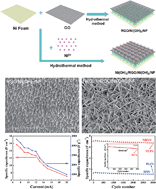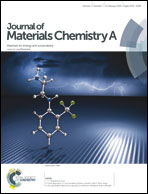Synthesis of Ni(OH)2/RGO pseudocomposite on nickel foam for supercapacitors with superior performance†
Abstract
A unique structure consisting of two kinds of Ni(OH)2 layers on the top and the bottom, respectively, of the same reduced graphene oxide (RGO) layer has been designed and synthesized through a facile hydrothermal process. The lower layer of Ni(OH)2, covered with a thin RGO film, is transformed in situ from the surface of a Ni foam substrate through the redox reaction of elemental Ni and graphene oxide (GO), while the upper layer of Ni(OH)2 nanoflakes from Ni ions in the solution is vertically assembled on the top surface of the RGO of the lower RGO/Ni(OH)2 layer. This composite can be regarded as combining RGO with a “pseudocomposite” of Ni(OH)2 material because the upper and lower Ni(OH)2 layers are different in morphology, particle size, and Ni2+ source. The bottom layer mainly acts as a rough support, while the upper Ni(OH)2 is suitable to act as the main active material for supercapacitor electrodes. The lower layer of Ni(OH)2/RGO, however, plays key roles in forming the aligned structure and in the subsequent cycling stability. The composite film has a high areal mass loading of 4.7 mg cm−2, and superior supercapacitor performance. It features a specific capacitance of up to 15.65 F cm−2 (i.e., 3328.7 F g−1) at a current density of 7 mA cm−2 (1.5 A g−1) and a capacity retention of 90.6%, even after 5000 cycles at the high rate of 20 mA cm−2 (4.3 A g−1), indicating that it has a promising application as an efficient electrode for high-performance supercapacitors.

- This article is part of the themed collection: JMC A Top Picks web collection: Advances in supercapacitors

 Please wait while we load your content...
Please wait while we load your content...